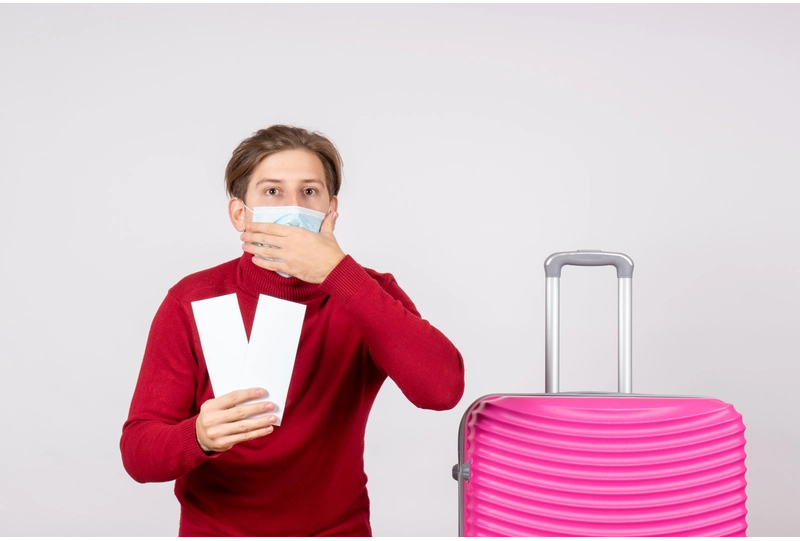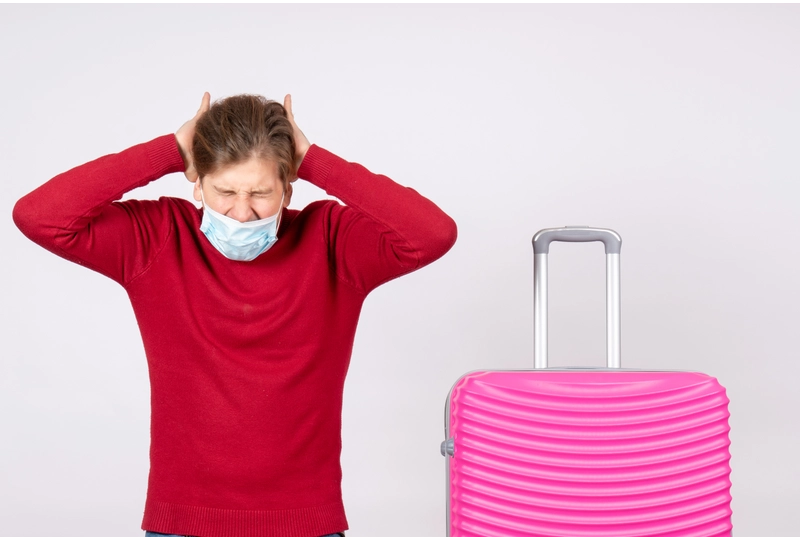Discover expert motion sickness relief: best seats, horizon focus, fresh air, ginger, hydration, and meds like Dramamine or patches.
Hey friends! As someone who’s been hopping planes, trains, and boats for years, I’ve had my fair share of queasy moments. Motion sickness can turn an exciting trip into a miserable one, but I’ve learned some tricks to keep it at bay. Let’s hang out and chat about how I tackle motion sickness so you can enjoy your travels without the spins. Here’s my go-to guide, packed with tips from my own adventures and research, to help you stay steady on the move.
Understanding Motion Sickness
Picture this: I’m on a winding road trip through the Rockies, and my stomach starts doing flips. Motion sickness happens when your brain gets mixed signals from your eyes, inner ears, and body about movement. It’s like your senses are arguing, and your stomach is caught in the crossfire. Common triggers include curvy roads, choppy seas, or turbulent flights. Knowing what causes it helps me prepare better.
Symptoms hit me like nausea, dizziness, sweating, and sometimes a headache. For some, it’s mild; for others, it’s a full-on battle. I’ve noticed it’s worse when I’m tired or stressed. Kids and women seem to get it more, but no one’s immune. Understanding this helps me stay one step ahead.

Preparing Before Your Trip
Preparation is my secret weapon against motion sickness. Before I head out, I check my travel plans to spot potential triggers. Curvy bus routes or long ferry rides? I’m ready for them. I also tweak my diet and sleep schedule to keep my body strong. Here’s how I set myself up for success.
Choose Your Transport Wisely
I’ve learned to pick my transport like I pick my playlist—carefully. On planes, I book seats over the wings for less turbulence. For trains, I go for lower-level seats near the center. On buses, front seats facing forward help me keep my eyes on the horizon. Ferries? I stay on the deck for fresh air and a stable view.
Researching routes is key. I once took a coastal ferry instead of a mountain bus route to avoid nausea. If I’m driving, I take smoother highways when possible. Checking reviews on travel forums helps me know what to expect. It’s all about minimizing the bumps before they start.
Diet and Hydration
What I eat before a trip makes a huge difference. I skip heavy, greasy meals—no burgers or fries the night before a flight. Light snacks like crackers or fruit keep my stomach settled. I steer clear of alcohol and caffeine, which can mess with my balance. Hydration is huge, so I sip water all day.
Ginger is my go-to remedy. I pack ginger chews or sip ginger tea before boarding. Once, on a choppy boat ride in Greece, ginger candies saved me from turning green. I also avoid eating right before travel—give your stomach a break! Small, frequent meals work best for me.

Medications and Supplements
Sometimes, I need a little extra help. Over-the-counter meds like Dramamine or Bonine work wonders if I take them 30 minutes before travel. They make me drowsy, so I plan naps on long flights. For prescription options, I’ve tried scopolamine patches for cruises—they’re a game-changer. Always check with a doctor first.
Natural supplements like ginger capsules or peppermint oil are in my travel kit. I’ve also heard vitamin B6 helps some people, though I haven’t tried it. On a road trip through Italy, I used a patch and felt great despite the winding roads. Test meds before your trip to avoid surprises.
During Your Journey
Once I’m on the move, I’ve got strategies to keep motion sickness from sneaking up. It’s all about controlling my environment and staying focused. Whether I’m on a plane or a boat, these tricks keep me steady. Let’s break it down.
Positioning and Focus
Where I sit matters. On a plane, I stare out the window to sync my eyes with the motion. On a car ride, I focus on the horizon or a distant point. It’s like telling my brain, “We’re all on the same page here.” I avoid reading or scrolling on my phone—it’s a nausea trigger.
I once tried reading on a curvy bus ride in Peru—big mistake. Staring at the scenery instead kept me grounded. If I’m in a car, I volunteer to drive; it gives me control and focus. For boats, standing midship with fresh air works like a charm.
Breathing and Relaxation
Deep breathing is my secret weapon. When I feel queasy, I take slow, deep breaths—inhale for four, exhale for six. It calms my nervous system and distracts me from nausea. I also use visualization, imagining a calm beach to relax my mind. Meditation apps help on long flights.
On a turbulent flight to Japan, I popped in earbuds with calming music. It shifted my focus and eased the spins. Progressive muscle relaxation—tensing and releasing muscles—also works. Stress makes motion sickness worse, so staying chill is key. Try it next time you’re feeling off.
Acupressure and Wristbands
I swear by acupressure wristbands like Sea-Bands. They press on the Nei-Kuan point on your wrist, which can reduce nausea. I wore them on a ferry in Norway and felt fine despite rough seas. You can also press the point yourself with your thumb. It’s simple and drug-free.
I’ve also tried tapping other pressure points, like the one between my thumb and index finger. It’s not foolproof, but it helps. My friend swears by essential oils like lavender on her wrists for extra calm. Experiment to see what clicks for you. It’s all about finding your groove.
Coping with Symptoms on the Spot
Sometimes, motion sickness hits despite my best efforts. When that happens, I’ve got quick fixes to ease the discomfort. These are my go-to moves for mid-trip relief. No need to suffer in silence—here’s what I do.
Quick Relief Techniques
If nausea creeps in, I suck on ginger candy or sip peppermint tea. Both are easy to carry and work fast. I also keep a small fan or open a window for fresh air—it’s a lifesaver on stuffy buses. Closing my eyes and leaning back helps reset my senses.
On a bumpy train ride in India, I used a cold pack on my forehead. It cooled me down and distracted me from the queasiness. Smelling a lemon slice or peppermint oil can also jolt me out of nausea. Keep these in your bag for emergencies.
Snacking Smart
Eating the right snacks mid-trip can tame my stomach. I munch on dry crackers, pretzels, or plain toast. They’re bland and absorb stomach acid without overwhelming me. I avoid sugary or fatty snacks—they make things worse. A small apple slice works too.
I learned this the hard way on a long-haul flight. Greasy plane food sent me spiraling, but crackers brought me back. Sip water or a clear soda like ginger ale slowly. Chugging liquids can upset your stomach more. Keep snacks handy for quick relief.
Special Considerations for Different Travelers
Motion sickness doesn’t hit everyone the same way. Kids, pregnant women, and frequent travelers like me all need tailored strategies. I’ve picked up tips from my own trips and talking to others. Here’s how I adjust for different needs.
Traveling with Kids
Kids are prone to motion sickness, and I’ve seen it on family trips. I keep them entertained with games like “I Spy” to distract from the motion. Sitting them in the front seat or giving them a window view helps. I pack kid-friendly ginger chews or lollipops.
On a road trip with my niece, I gave her a small toy to focus on. It worked better than a screen, which can worsen nausea. Frequent breaks for fresh air are a must. I also tell parents to avoid heavy meals before travel—light snacks only.
Pregnant Travelers
Pregnancy can amplify motion sickness—I’ve heard this from friends. I recommend ginger tea or crackers, which are safe for most pregnant women. Wristbands are a great non-medication option. Always check with a doctor before using any meds or supplements.
A pregnant friend swore by small, frequent sips of water on a cruise. She also stayed on deck for fresh air. Avoiding strong smells, like perfume or food, helps too. Comfortable seating and loose clothing make a big difference. Stay hydrated and rest as much as you can.
Frequent Travelers
As someone who travels often, I’ve built a routine. I always carry my motion sickness kit: wristbands, ginger chews, and Dramamine. I book seats strategically and stick to my pre-trip diet. Regular meditation keeps my stress low, which helps. I also track which routes or vehicles trigger me.
On a multi-leg trip through Southeast Asia, I learned to pace myself. Short naps between flights or bus rides recharge me. If you travel a lot, experiment with remedies to find your perfect combo. Consistency is key to staying comfortable.
Long-Term Strategies
Motion sickness doesn’t have to be a lifelong curse. I’ve worked on long-term fixes to reduce its grip on me. These take time but have made my travels smoother. Here’s what I’ve been doing to build resilience.
Training Your Body
I’ve trained my body to handle motion better. It’s like building a tolerance to spicy food—start small. I take short car rides on curvy roads to get used to the feeling. Simulators or virtual reality games can mimic motion safely. I tried this before a cruise, and it helped.
Gradual exposure works. I started with 10-minute drives, then longer ones. Over time, my brain adjusted to the motion cues. Yoga or balance exercises also strengthen my inner ear. It’s not instant, but it’s worth the effort.
Consulting a Specialist
If motion sickness is a constant battle, I see a doctor. ENT specialists or neurologists can check for underlying issues like inner ear problems. I once got a balance test that pinpointed why I was so sensitive. They might suggest therapy or specific meds.

Vestibular rehab is another option I’ve explored. It’s like physical therapy for your balance system. A friend with chronic motion sickness saw huge improvements after a few sessions. Don’t be afraid to ask for professional help—it can change your travel game.
Travel-Specific Tips
Different modes of travel bring unique challenges. I’ve got tips for each, honed from years of hopping around. Whether you’re flying, driving, or sailing, here’s how I stay steady. Let’s dive into the specifics.
Air Travel
Flights can be rough, especially with turbulence. I book seats over the wings and keep my eyes on the horizon through the window. Eating light before boarding is a must. I also use noise-canceling headphones with calming music to stay relaxed.
On a bumpy flight to Iceland, I chewed ginger gum and used a wristband. It kept me calm through the shakes. Avoid alcohol and caffeine on board—they dehydrate you and worsen symptoms. Sip water and take deep breaths during rough patches.
Road Trips
Driving or riding in a car can trigger motion sickness fast. I sit in the front seat and focus on the road ahead. If I’m a passenger, I avoid looking down at my phone. Frequent stops for fresh air help, especially on winding roads.
I once drove through the Alps and took breaks every hour. It reset my senses and kept nausea away. Keep the car cool and well-ventilated. If you’re driving, take control—it reduces the disconnect between your eyes and body.
Cruises and Ferries
Boats are my toughest challenge. I stay on deck, midship, where motion is minimal. Watching the horizon steadies my brain. I also wear wristbands and sip ginger ale. Avoiding the lower decks or enclosed spaces is key.
On a ferry in the Caribbean, I stood outside and breathed deeply. It made the choppy ride bearable. If you’re on a cruise, book a cabin near the ship’s center. Pop a Dramamine before boarding for extra protection.
Packing Your Motion Sickness Kit
I never travel without my motion sickness kit. It’s like my travel security blanket. Here’s what I pack to stay prepared. It’s saved me on countless trips.
Must-Have Items
My kit includes ginger chews, Sea-Bands, and Dramamine. I also pack peppermint oil, crackers, and a reusable water bottle. A small fan or cooling cloth helps with stuffy spaces. I keep everything in a compact pouch for easy access.
On a train in Thailand, my kit was a lifesaver. The ginger and wristbands kept me steady through the bumps. I also toss in earplugs and a sleep mask for restful naps. Test your kit on short trips to make sure it works.
Organizing for Easy Access
I keep my kit in my carry-on, not checked luggage. A clear ziplock bag makes it easy to grab what I need. I label everything to avoid fumbling during a queasy moment. It’s all about quick access when nausea hits.
Once, on a flight, I spilled my bag searching for ginger candy. Now, I use a small organizer with compartments. It keeps things tidy and stress-free. Pro tip: pack extras in case of delays or lost luggage.
Frequently Asked Questions
What’s the best way to prevent motion sickness before a trip? I start with preparation: eat light, stay hydrated, and avoid alcohol or caffeine. Ginger chews or tea work great, and I might take Dramamine 30 minutes before travel. Booking the right seat—like over the wings on a plane—also helps. Check with a doctor for personalized advice.
Can kids use motion sickness remedies? Yes, but be careful. I use kid-friendly ginger candies or wristbands for my niece. Some meds like Dramamine have pediatric versions, but always check with a pediatrician first. Distractions like games or window views work well for kids too.
Are natural remedies effective for motion sickness? In my experience, yes! Ginger, peppermint, and acupressure wristbands have helped me on many trips. They’re not always as strong as meds, but they’re gentler and drug-free. Try them out to see what works for you.
How do I handle motion sickness on a cruise? I stay midship on the deck, watching the horizon. Wristbands and ginger ale are my go-tos. Book a central cabin and take Dramamine before boarding. Avoid enclosed spaces and heavy meals to keep nausea at bay.
Can I train myself to avoid motion sickness? Definitely! I’ve built tolerance with short, curvy drives and balance exercises like yoga. Gradual exposure to motion helps your brain adjust. Vestibular therapy can also work wonders—talk to a specialist for a tailored plan.
Conclusion
Motion sickness doesn’t have to ruin your adventures. With these tips—learned from my own travels and plenty of trial and error—you can keep nausea at bay and18 and enjoy every moment of your trip. From smart prep to on-the-spot remedies, you’ve got options to stay comfortable. Pack your motion sickness kit, plan ahead, and hit the road with confidence. Happy travels, friends!



